
The little grebe, also known as dabchick, is a member of the grebe family of water birds. The genus name is from Ancient Greek takhus "fast" and bapto "to sink under". The specific ruficollis is from Latin rufus "red" and Modern Latin -collis, "-necked", itself derived from Latin collum "neck".

Gmelina arborea,, locally known as gamhar, is a fast-growing deciduous tree in the family Lamiaceae.

Endoclita is a genus of moths of the family Hepialidae. There are 60 described species found in eastern and southeast Asia and the Indian subcontinent.

Gallirallus is a genus of rails that live in the Australasian-Pacific region. The genus is characterised by an ability to colonise relatively small and isolated islands and thereafter to evolve flightless forms, many of which became extinct following Polynesian settlement.

The buff-banded rail is a distinctively coloured, highly dispersive, medium-sized rail of the rail family, Rallidae. This species comprises several subspecies found throughout much of Australasia and the south-west Pacific region, including the Philippines, New Guinea, Australia, New Zealand, and numerous smaller islands, covering a range of latitudes from the tropics to the subantarctic.

The Philippine warty pig is one of four known species in the pig genus (Sus) endemic to the Philippines. They have tufts of hair on the top of their head and on the lower sides of their jaws, as well as four warts on their faces. Their skulls are elongated; males have tusks and bigger skulls than females, an example of sexual dimorphism. They are considered Vulnerable by the IUCN, and their population is currently declining due to multiple threats. The pigs are probably nocturnal.
The Catalogue of Life is an online database that provides an index of known species of animals, plants, fungi, and microorganisms. It was created in 2001 as a partnership between the global Species 2000 and the American Integrated Taxonomic Information System. The Catalogue is used by research scientists, citizen scientists, educators, and policy makers. The Catalogue is also used by the Biodiversity Heritage Library, the Barcode of Life Data System, Encyclopedia of Life, and the Global Biodiversity Information Facility. The Catalogue currently compiles data from 165 peer-reviewed taxonomic databases that are maintained by specialist institutions around the world. As of September 2022, the COL Checklist lists 2,067,951 of the world's 2.2m extant species known to taxonomists on the planet at present time.
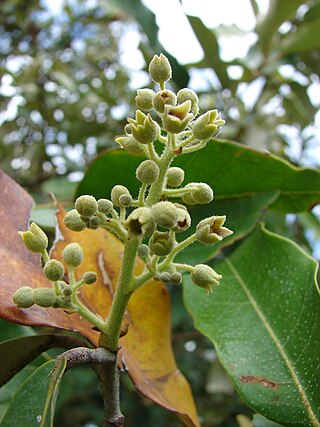
Heritiera is a genus of flowering plants in the family Malvaceae, subfamily Sterculioideae. They are most dominant tropical forest trees in several areas in eastern Africa and India to the Pacific. Some are mangroves. Several are valuable for their timber and are over-exploited.
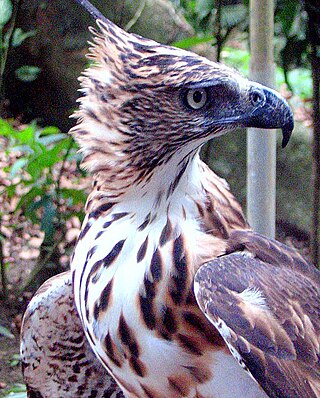
The Philippine hawk-eagle or north Philippine hawk-eagle, earlier treated under Spizaetus, is a species of bird of prey in the family Accipitridae. Many taxonomists consider the Pinsker's hawk-eagle, a former subspecies, raised to full species status. It is endemic to the Philippines. Its natural habitat is tropical moist lowland forests. It is threatened by habitat loss and trapping.
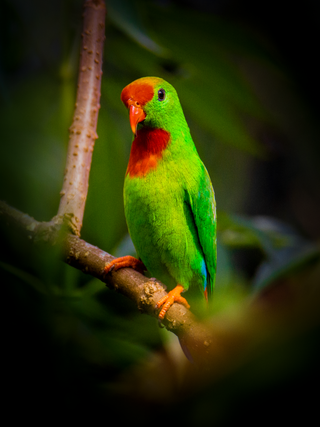
The Philippine hanging parrot, also commonly known as the colasisi from its local Tagalog name "kulasisi", is a small psittaculid parrot species endemic to the Philippines. It includes about eleven subspecies, at least one of which might represent a distinct species, although further research is needed. While it is listed as Least Concern in IUCN, some subspecies, such as L. p. chyrsonotus of Cebu and L. p. siquijorensis of Siquijor, may already be extinct. The species is threatened by habitat loss, but a bigger threat is trapping for the illegal wildlife trade; wild-caught birds are often sold as pets in streets and online selling groups.

The Philippine hawk-owl is a species complex of owls in the genus Ninox. They are all endemic to the Philippines.

The Indian giant flying squirrel, also called the large brown flying squirrel or the common giant flying squirrel, is a species of rodent in the family Sciuridae. It is capable of gliding flight using a skin membrane, the patagium, stretched between front and hind legs. It is found in mainland Southeast and South Asia, and southern and central China.
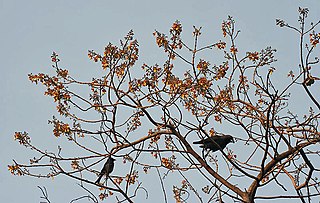
Gmelina is a genus of plants in the family Lamiaceae. It consists of about 35 species in Australia, New Guinea, New Caledonia, Southeast Asia, India and a few in Africa. Some species such as G. arborea have been planted and/or become naturalised in India, Africa and Australia. It was named by Carl Linnaeus in honour of botanist Johann Georg Gmelin.
The Macquarie rail, also known as the Macquarie Island rail, is an extinct subspecies of the buff-banded rail endemic to Macquarie Island, a subantarctic island that is part of the state of Tasmania, Australia. The holotype is in the collection of the Museum of New Zealand Te Papa Tongarewa.

Capparis zeylanica is a climbing shrub common in the forests of the Indian subcontinent, Indo-China, China and Malesia; no subspecies are listed in the Catalogue of Life. Several species of Lepidopteran larvae feed on its leaves.

The Luzon boobook or Luzon hawk owl, also Philippine hawk owl or Philippine boobook, is a species of owl in the family Strigidae. It is endemic to the Philippines where it lives in forests. It is a brown and white mottled bird and males and females look much alike.

Ryania is a genus of flowering plants in the family Salicaceae; it was previously listed in the now defunct family Flacourtiaceae.
Cusiala raptaria is a moth of the family Geometridae first described by Francis Walker in 1860. It is found in the Indian subregion and Sri Lanka.
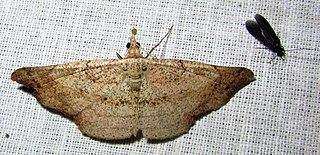
Ozola minor is a moth of the family Geometridae first described by Frederic Moore in 1888. It is found in Sri Lanka, India, the Andaman Islands, Sumatra, Borneo, the Philippines and Sulawesi.

Gmelina asiatica is a plant species, described by Linnaeus, in the family Lamiaceae. No subspecies are listed in the Catalogue of Life.




















